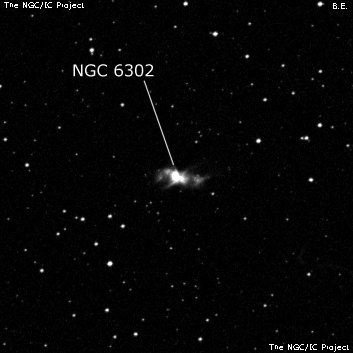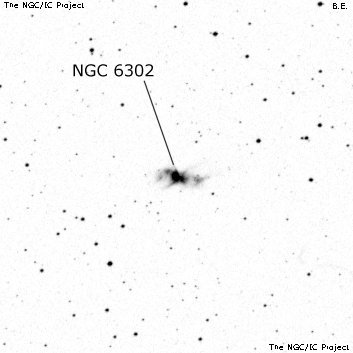NGC/IC Project Restoration Effort
(This is a very very beta version)
NGC6302


Basic Information
Location and Magnitude
Right Ascension: 17:13:44.1
Declination: -37:6:12
Constellation: SCO
Visual Magnitude: 9.6
Historic Information
Discoverer: Barnard
Year of discovery: 1880
Discovery aperture: 5.0
Observational
Summary description: pB, E pf (Swift: triple)
Sub-type: PN
Corwin's Notes
=====
NGC 6302. This beautiful and well-known planetary nebula (made famous by the
HST images) has two main lobes -- the eastern lobe is the brighter --
consisting of knots and streamers, apparently blown off the (unseen) central
star. Brian and I have attempted to estimate the position of the star by
choosing a point between the two bright arcs that nearly intersect in the
center of the nebula. Unfortunately, the RA is not well-constrained and
differs by about 3 arcseconds depending on which DSS image is used. The DSS1
image from the quick V plate gives the clearest view, so that is the one I
have adopted. The positions of the lobes are reasonably well-determined from
the automated surveys.
Steve's Notes
=====
NGC 6302
18" (7/22/06): fascinating view unfiltered at 325x. In the center is a very high surface brightness "core" of only 10"-12" in diameter that brightens slightly to the center and is encased in a larger, fainter envelope. Extending from the central core are two remarkable wings oriented WSW-ENE. The following wing is much shorter but slightly brighter and this extension abruptly shoots towards the southeast near the end. The much longer preceding wing heads WSW and is cut by a darker lane that detaches the western tip.
17.5" (6/30/00): at 280x (unfiltered) the Bug Nebula is a remarkable, high surface brightness object, elongated 3:1 WSW-ENE, ~2.0x0.7'. The intensely bright 10" core appears elongated SW-NE and is offset to the east of center. A quasi-stellar nucleus sharpens to a stellar point when the seeing steadies (this is not the central star, though). The western wing is longer and is nearly split at the midpoint by a dark slash oriented N-S with a brighter condensation at the west end. The shorter eastern wing is more pinched and just past its midpoint there is a kink and it angles towards the SE.
13.1" (7/27/84): structure highly suspected with the western extension cut by a dark lane. The eastern extension bends north following the core.
13.1" (7/5/83): bright, fairly small, elongated E-W, very high surface brightness. Subtle structure but the western extension is notably longer, brighter and possibly cut by a dark lane.
8" (6/27/81): fairly bright, small, elongated, bright core and brighter along the western extension.



